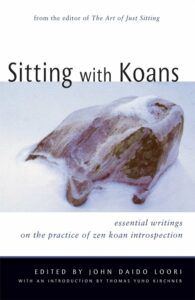Koan
In this lesson we practice a koan meditation for the first time. The history of koans goes back to the period between the 8th and 10th centuries AD. In China, teachers at the time also used to ask questions of their students to test how much the students already understood what ‘it’ was about. The word koan is a corruption of the Chinese word kung-an, meaning “public statement or question.” Such a public question and answer game was the basis of what we understand today by koans.
Over time, the way koans were handled changed. From a question asked by a teacher in the middle of a group of students, it became more and more a process between the teacher and one student at a time. The teacher asks a question and the student answers it.
A koan is not an ordinary question to which a rational answer is possible. A koan is often a question that sounds very absurd, and to which you initially do not know how to answer it. A koan, like zazen (sitting meditation) and kinhin (walking meditation), is an exercise in mindfulness. A means to bundle your concentration; becoming one with the koan. The point here is that you allow yourself to take other ways to arrive at an answer than strictly your rationality and your sober mind. You have to throw in everything you have and also what you don’t have, but need to develop (inventiveness / creativity, feeling, emotions, body, intuition, deeper layers of consciousness, sense of unity, etc).
 Practically it works like this: your teacher gives you a koan. Then you focus on that koan during meditation, instead of counting the exhalation, which we do now. You can see it a bit like a mantra, which you also repeat. Through the repetition you get deeper to the heart of the matter.
Practically it works like this: your teacher gives you a koan. Then you focus on that koan during meditation, instead of counting the exhalation, which we do now. You can see it a bit like a mantra, which you also repeat. Through the repetition you get deeper to the heart of the matter.
Then when you get another opportunity to be alone with your teacher, he asks what your koan was and you answer. If it’s not right, the teacher will often ring a bell, after which you return to your seat; if the answer is correct, the teacher often asks for more clarification and then gives you a new/next koan.
Book to read: Sitting with koans, by John Daido Loori. You can download this for free here.
